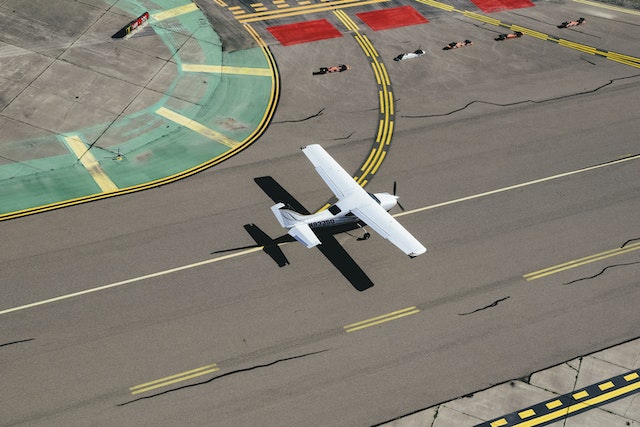The experience of piloting a light aircraft may be both thrilling and fulfilling. Yet, ensuring safety measures are followed to reduce dangers and avoid mishaps is crucial. While piloting a small aircraft, remember these five points:
Things to Keep in Mind Before Taking Off on a Small Plane
1. Weather Check
Checking the weather conditions is a crucial part of ensuring a safe and successful flight. Before flying, pilots should review the current weather forecast and closely monitor any changes that may occur throughout the flight. The weather check should include an analysis of the temperature, visibility, wind speed and direction, cloud coverage, precipitation, and other weather conditions that may affect the flight.
In addition, pilots should be aware of any weather patterns or systems that could develop during the flight and be prepared to adjust their course accordingly. It is also recommended to check the weather conditions at the destination airport and alternate airports in case of an emergency or unexpected weather changes. Pilots can access weather information from various sources, including weather websites, aviation weather services, and local airport weather stations. By performing a thorough weather check, pilots can make informed decisions about the safety of the flight and ensure a smooth journey for all passengers onboard.
2. Pre-Flight Inspection
A pre-flight check must ensure the aircraft is safe to fly. Inspecting the battery, oil, brakes, tires, and controls is important. Before taking off, any problems or flaws should be fixed. Before flying a small plane, it’s important to check the accuracy of the airspeed indicator by using an air data test set.
3. Weight and Balance Check
Weight and balance check is essential to ensuring a small aircraft’s safety. This check involves calculating the weight and center of gravity of the airplane. If the weight is too heavy or distributed unevenly, it can affect the plane’s handling and performance during flight, making it more challenging to control.
To conduct a weight and balance check, you need to know the weight of the airplane, including fuel, passengers, and luggage. Then you have to calculate the center of gravity, which is the point where the airplane balances. The center of gravity must be within limits specified in the aircraft’s manual, or the plane may become unstable during flight.
4. Proper Training
Proper training is crucial for any pilot who wants to fly a small aircraft safely. To obtain a pilot’s license, an aspiring pilot must pass rigorous training and testing, including flight training and ground school instruction. Even after obtaining a pilot’s license, regular recurrent training is required to ensure that pilots remain up-to-date on the latest safety procedures, as well as to maintain their proficiency in operating an aircraft.
A pilot’s training includes learning how to handle emergency situations, such as engine failure. Pilots must also understand the principles of aerodynamics and how to navigate using instruments and visual cues.
5. Emergency Procedures
Emergency procedures are essential for every pilot to know, as they may face unexpected situations during flight. Engine failure, communication failure, and other emergencies can arise without warning, so being well-versed in the proper protocols is crucial. When an emergency occurs, pilots should remain calm, assess the situation, and take action quickly. It is critical to remember that panicking can make the situation worse. Proper communication with air traffic control and passengers is also important during an emergency.
Pilots should be aware of their options and know how to communicate with ground personnel for help. They should be well-trained in handling fire emergencies, emergency landings, and evacuating passengers in case of an emergency. Additionally, it is essential to have an emergency plan in place before the flight, which includes carrying the appropriate emergency equipment on board. The emergency plan should also include a checklist that pilots can use to ensure they follow the proper procedures in case of an emergency.
Benefits of Flying a Small Plane
Sense of Freedom
Nothing quite like the feeling of autonomy and independence in a small aircraft compared to a commercial trip. With additional options for flight planning and customization, pilots can create a unique and thrilling flight experience for themselves and their passengers.
Improved Pilot Skills
A pilot’s abilities and knowledge may benefit from time spent in the cockpit of a small aircraft, where they have more direct involvement with the flying controls and navigation systems. Because of this, pilots may gain confidence and skill.
Scenic Views
Spectacular bird’s-eye views of landscapes and towns may be seen from the cockpit of a tiny aircraft that would otherwise be inaccessible. Passengers may have a bird’s-eye view of the ground below, which can be educational and entertaining.
Services that Are Using Small Planes
Air Taxi Services
Transportation may be arranged on short notice with the help of air taxi services. Both business and pleasure travelers make frequent use of these services. Airports with shorter runways and smaller airports may be closer to a passenger’s final destination, making air taxis more flexible and convenient than commercial airlines.
Aerial Photography
Photographers regularly employ small aircraft for aerial photography, which allows them to capture breathtaking vistas from above. Several industries rely on this photography, including advertising, real estate, and surveying.
Conclusion
In conclusion, piloting a light aircraft may be exhilarating, but safety must always come first. By taking these five measures, you may reduce the likelihood of an accident and increase the likelihood of having a pleasant trip in a tiny aircraft.
